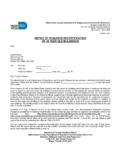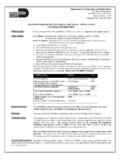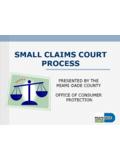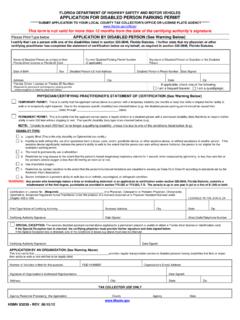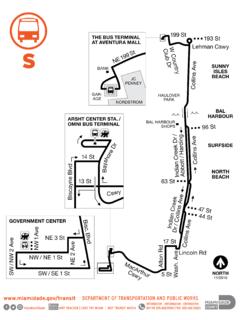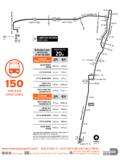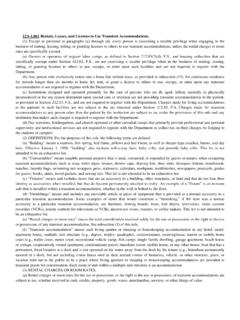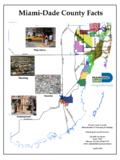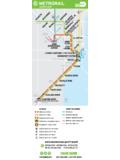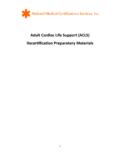Transcription of Revised Structural recertification form
1 GENERAL CONSIDERATIONS SCOPE OF Structural INSPECTION The fundamental purpose of the required inspection and report is to confirm in reasonable fashion that the building or structure under consideration is safe for continued use under the present occupancy. As implied by the title of this document, this is a recommended procedure, and under no circumstances are these minimum recommendations intended to supplant proper professional judgment. Such inspection shall be for the purpose of determining the general Structural condition of the building or structure to the extent reasonably possible of any part, material or assembly of a building or structure which affects the safety of such building or structure and/or which supports any dead or designed live load, and the general condition of its electrical systems pursuant to the Building Code. In general, unless there is obvious overloading, or significant deterioration of important structure elements there is little need to verify the original design.
2 It is obvious that this has been time tested if still offering satisfactory performance. Rather, it is of importance that the effects of time with respect to deterioration of the original construction materials be evaluated. It will rarely be possible to visually examine all concealed construction, nor should such be generally necessary. However, a sufficient number of typical structure members should be examined to permit reasonable conclusions to be drawn. Visual Examination will, in most cases, be considered adequate when executed systematically. The visual examination must be conducted throughout all habitable and non-habitable areas of the building, as deemed necessary by the inspecting professional to establish compliance. Surface imperfections such as cracks, distortion, sagging, excessive deflections, significant misalignment, signs of leakage, and peeling of finishes should be viewed critically as indications of possible difficulty.
3 Testing Procedures and quantitative analysis will not generally be required for five (5) Structural members or systems except for such cases where visual examination has revealed such need, or where apparent loading conditions may be critical. Manual Procedures such as chipping small areas of concrete and surface finishes for closer examinations are encouraged in preference to sampling and/or testing where visual examination alone is deemed insufficient. Generally, unfinished areas of buildings such as utility spaces, maintenance areas, stairwells and elevator shafts should be utilized for such purposes. In some cases, to be held to a minimum, ceilings or other construction finishes may have to be opened for selective examination of critical Structural elements. In that event, such locations should be carefully located to be least disruptive most easily repaired, and held to a minimum.
4 In an event, a sufficient number of Structural members must be examined to afford reasonable assurance that such are representative of the total structure. Evaluating an existing structure for the effect of time, must take into account two, basic considerations; movement of Structural components with respect to each other, and deterioration of materials. With respect to the former, volume change considerations, principally from ambient temperature changes, and possible long time deflections, are likely to be most significant. Foundation movements will frequently be of importance, usually settlement, although upward movement due to expansive soils actually may occur. However, it is infrequent in this area. Older buildings on spread footings may exhibit continual, even recent settlements if founded on deep unconsolidated fine grained or cohesive soils or from subterraneous losses or movements from several possible causes.
5 With very little qualification, such as rather rare chemically reactive conditions, deterioration of building materials can only occur in the presence of moisture, largely to metals and their natural tendency to return to the oxide state in the corrosive process. In this marine climate, highly aggressive conditions exist year round. For most of the year, outside relative humidity may frequently be about 90 or 95%, while within air-conditioned buildings, relative humidity will normally be about 35 to 60%. Under these conditions moisture vapor pressures ranging from about 1/3 to 1/2 pounds per square inch will exist much of the time. Moisture vapor will migrate to lower pressure areas. Common building materials such as stucco, masonry and even concrete, are permeable even with these slight pressures. Since most of our local construction does not use vapor barriers, condensation will take place within the enclosed walls of the building.
6 As a result, deterioration is most likely adjacent to exterior walls, or wherever else moisture or direct leakage has been permitted to penetrate the building shell. Structural deterioration will always require repair. The type of repair, however, will depend on the importance of the member in the Structural system and degree of deterioration. Cosmetic type repairs may suffice in certain non-sensitive members such as tie beams and columns, provided that the remaining sound material is sufficient for the required function. For members carrying assigned gravity or other loads, cosmetic type repairs will only be permitted if it can be demonstrated by rational analysis that the remaining material, if protected from further deterioration can still perform its assigned function at acceptable stress levels. Failing that, adequate repairs or reinforcement will be considered mandatory.
7 Written Reports shall be required attesting to each required inspection. Each such report shall note the location of the structure, description of type of construction, and general magnitude of the structure, the existence of drawings and location thereof, history of the structure to the extent reasonably known, and description of the type and manner of the inspection, noting problem areas and recommending repairs, if required to maintain Structural integrity. EVALUATION Each report shall include a statement to the effect that the building is structurally safe, unsafe, safe with qualifications, or has been deemed safe by restrictive interpretation of such statements. It is suggested that each report also include the following information indicating the actual scope of the report and limits of liability. This paragraph may be used: As a routine matter, in order to avoid possible misunderstanding, nothing in this report should be construed directly or indirectly as a guarantee for any portion of the structure.
8 To the best of my knowledge and ability, this report represents and accurate appraisal of the present condition of the building based upon careful evaluation of observed conditions, to the extent reasonably possible. FOUNDATION: If all of the supporting subterranean materials were completely uniform beneath a structure, with no significant variations in grain size, density, moisture content or other mechanical properties; and if dead load pressures were completely uniform, settlements would probably be uniform and of little practical consequence. In the real world, however, neither is likely. Significant deviations from either of these two idealism are likely to result in unequal vertical movements. Monolithic masonry, generally incapable of accepting such movements will crack. Such cracks are most likely to occur at corners, and large openings. Since, in most cases, differential shears are involved, cracks will typically be diagonal.
9 Small movements, in themselves, are most likely to be structurally important only if long term leakage through fine cracks may have resulted in deterioration. In the event of large movements, continuous Structural elements such as floor and roof systems must be evaluated for possible fracture or loss of bearing. Pile foundations are, in general, less likely to exhibit such difficulties. Where such does occur, special investigation will be required. ROOFING SYSTEMS: Sloping roofs, usually having clay or cement tiles, are of concern in the event that the covered membrane may have deteriorated, or that the tiles may have become loose. Large deflections, if merely resulting from deteriorated rafters or joists will be of greater importance. Valley Flashing, and Base Flashing at roof penetration will also be matters of concern.
10 Flat roofs with built up membrane roofs will be similarly critical with respect to deflection considerations. Additionally, since the will generally be approaching expected life limits at the age when building recertification is required, careful examination is important. Blisters, wrinkling, alligatoring, and loss of gravel are usually signs of difficulty. Punctures or loss of adhesion of base flashing, coupled with loose counterflashing will also signify possible problems. Wind blown gravel, if excessive, and the possibility of other debris, may result in pounding, which if permitted, may become critical. MASONRY BEARING WALLS Random cracking, or if discernible, definitive patterns of cracking, will of course, be of interest. Bulging, sagging, or other signs of misalignment may also indicate related problems in other Structural elements. Masonry walls where commonly constructed of either concrete masonry remits or scored clay tile, may have been constructed with either reinforced concrete columns tie beams, or lintels.
